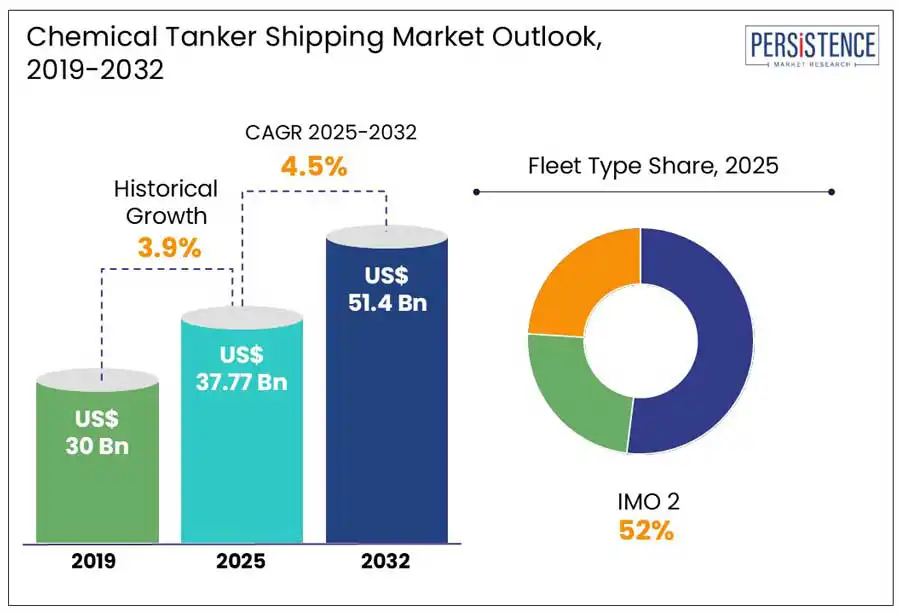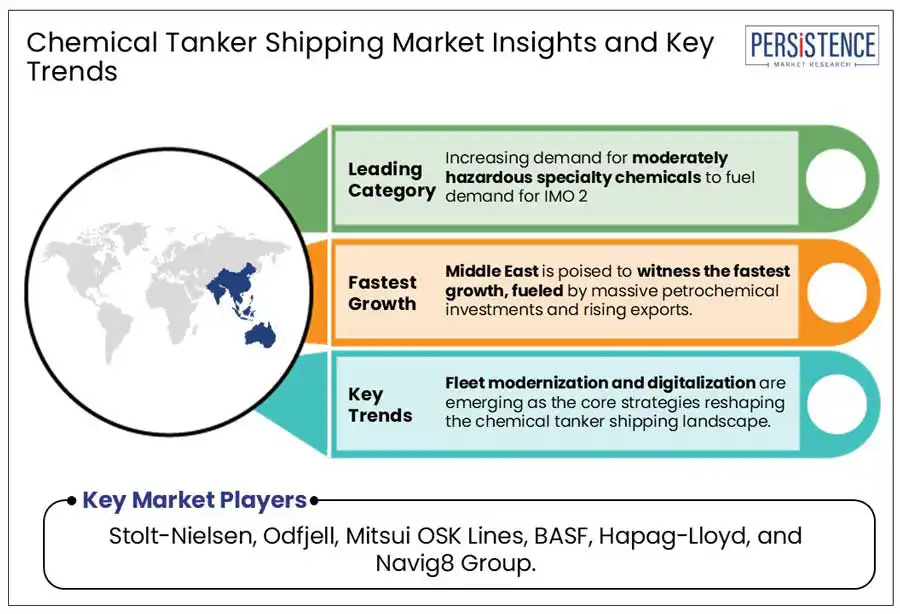Comprehensive Snapshot for Chemical Tanker Shipping Market Including Regional and Country Analysis in Brief
Industry: Automotive & Transportation
Published Date: April-2025
Format: PPT*, PDF, EXCEL
Delivery Timelines: Contact Sales
Number of Pages: 150
Report ID: PMRREP35220
The global chemical tanker shipping market size is anticipated to be valued at US$ 37.77 Bn in 2025. The market is projected to grow by US$ 51.40 Bn at a CAGR of 4.5% by 2032.
According to Persistence Market Research, the market is witnessing considerable growth fueled by increasing demand for innovation and necessity. Factors such as stringent environmental regulations, increasing demand for specialty chemicals, technological advancements, and rising sea-borne trades are expected to create considerable growth opportunities between 2025 and 2032. For instance, stringent maritime regulations such as the International Maritime Organization’s (IMO) sulfur emission cap (IMO 2020) and the Energy Efficiency Existing Ship Index (EEXI) are compelling companies to adopt cleaner, more efficient technologies to reduce emissions and improve fuel efficiency, leading to the adoption of modern, sustainable fleets.
In response to these shifts, established players such as Stolt-Nielsen, Odfjell, Mitsui OSK Lines, and BASF are making strategic investments in fleet modernization, forging key partnerships, and enhancing port infrastructure. By aligning with technological advancements and optimizing their global networks, these companies are positioning themselves for sustained growth in a rapidly evolving market.

Key Industry Highlights
|
Global Market Attribute |
Key Insights |
|
Chemical Tanker Shipping Market Size (2025E) |
US$ 37.77 Bn |
|
Market Value Forecast (2032F) |
US$ 51.40 Bn |
|
Projected Growth (CAGR 2025 to 2032) |
4.5% |
|
Historical Market Growth (CAGR 2019 to 2024) |
3.9% |
Increasing adoption of automation and digital tracking technologies is anticipated to boost market growth during the forecast period. Automated systems enable precise loading and unloading of sensitive chemicals, minimizing human error and enhancing safety. In parallel, modern ship designs are developed with energy-efficient hull structures and advanced propulsion systems which help reduce fuel consumption and lower emissions.
Moreover, digital fleet management tools allow real-time monitoring of vessel performance, route optimization, and predictive maintenance. These innovations reduce operational risks minimize downtime, extend vessel lifespan, and improve overall cost efficiency. Together, these technological advancements are transforming the operational landscape of chemical shipping making it safer, more efficient, and economically sustainable.
Volatility in freight rates pose a significant challenge. Frequent and sharp rate fluctuations make it difficult for operators to lock in long-term contracts or project cash flows, leading to reduced investment in fleet upgrades and expansion. Besides, companies also face budgeting difficulties, often postponing shipments or shifting to alternative transport modes, which lowers overall demand in the market.
In early 2024, freight rates surged due to Red Sea disruptions linked to geopolitical tensions, forcing vessels to take the longer Cape of Good Hope route. This particularly affected key segments such as organic chemicals, vegetable oils, and petrochemicals, where spot rate hikes of over 40% were witnessed. This strained operator finances and disrupted supply chains, emphasizing why volatility in freight rates is likely to restrict market growth to a certain extent.
Strategic fleet modernization presents an exciting growth opportunity for chemical tanker operators. Replacing aging vessels with modern, IMO-compliant ships ensures that operators meet stricter environmental regulations, such as sulfur emissions and energy efficiency standards. This approach helps companies avoid costly fines and retrofitting while enabling them to operate more sustainably and stay competitive in the market. According to surveys and studies, around 15% of the fleet operating in 2025 will be over 20 years old projected to rise to 35% within five years and 80% within ten years. In line with this trend, many shipping companies are already investing in fleet modernization. For instance, in November 2024, Hapag-Lloyd signed contracts with two China-based shipyards to construct 24 new container ships. The investment of US$ four billion is aimed to replace older vessels that are nearing the end of their service life, demonstrating the industry's shift toward more sustainable, modern fleets.
Investing in advanced tankers made from stainless steel or specialized coatings further enhance fleet flexibility. These modern vessels are capable of carrying a wider range of chemicals, including highly corrosive or temperature-sensitive ones. As a result, operators attract more customers across various chemical sectors, increasing fleet utilization. The ability to handle diverse shipments boosts operational efficiency enhances profitability, paving the way for long-term market growth.
Based on fleet type, the market is segmented into IMO 1, IMO 2, and IMO 3. Out of these, IMO 2 segment is expected to hold a share of about 52% in 2025 and dominate further. IMO 2 tankers are designed to transport moderately hazardous bulk liquids such as petroleum products, vegetable oils, and other organic as well as inorganic chemicals. The rising demand for chemicals such as caustic soda, methanol, and olefins, which fall into the IMO 2 category, from agriculture, automotive, construction, and manufacturing sectors, is anticipated to drive the segment’s growth.
On the other hand, IMO 1 segment is projected to witness substantial growth during the forecast period. Rising demand for highly hazardous and high-purity chemicals, such as acids and specialty solvents, is driving the demand for IMO 1 tankers. Additionally, stricter environmental and safety regulations are driving companies to upgrade their fleets to IMO 1-compliant vessels, which is anticipated to drive the growth of the segment.
Based on the product, the deep-sea segment is expected to witness significant growth, driven by growing intercontinental trade activities. Many large chemical producers and consumers are located across different regions, such as the U.S., Europe, and Asia. This makes deep sea routes essential for global supply chains. Deep-sea tankers have higher cargo capacities and are equipped to handle a wide range of chemicals safely over long-distance trade. This is acting as a growth catalyst for the segment.
The inland segment, on the other hand, is likely to register considerable growth in the forthcoming years. This growth is attributed to the increasing demand for specialty chemicals from densely industrialized areas with extensive river and canal networks. Inland tankers offer a cost-effective and environmentally friendly alternative to road transport, helping reduce traffic congestion and emissions.

Asia Pacific is anticipated to hold a share of about 38% in 2025 and dominate further. The region’s growth is attributable to the presence of established industrial bases in countries such as South Korea, China, India, and Japan. These bases are major producers of bulk and specialty chemicals and cater to the rising demand from agrochemicals, textiles, and pharmaceuticals industries. In addition, supportive government initiatives to develop port infrastructure are projected to spur the demand for the product. For instance, in China, initiatives under the Belt and Road Initiative (BRI) have led to substantial upgrades in key chemical-handling ports such as Ningbo-Zhoushan and Shanghai, with increased storage capacity and automated cargo handling systems specifically tailored for hazardous chemicals.
The China chemical tanker shipping market is likely to witness exceptional growth in the region during the forecast period. In recent years, China has ramped up its output of high-value-added chemicals such as ethylene oxide derivatives, coatings, and electronic-grade solvents, driven by booming downstream sectors such as EV battery production, semiconductors, and green energy. This creates a two-way demand in the logistics sector. For example, the import of raw materials such as methanol and naphtha and export of refined chemical products both require specialized chemical tanker services. Another growth factor is companies focusing on enhancing their port infrastructure, which is projected to surge the demand for the product during the forecast period.
The chemical tanker shipping industry in the Middle East is anticipated to be the fast-growing. With massive investments in petrochemical complexes, primarily in the Gulf Cooperation Council (GCC) countries, the region is rapidly expanding its chemical production capacity. The region's proximity to key international shipping routes, such as the Suez Canal, is expected to add to its strategic appeal, fueling the growth of the market in the forthcoming years.
Saudi Arabia chemical tanker shipping market is expected to witness a fast-growth during the forecast period. The country is witnessing heavy investments in integrated chemical complexes such as the Jubail Industrial City, which manufacturers everything from ammonia to ethylene glycols. These chemicals are shipped in bulk to Southeast and South Asia driving the demand for medium to large chemical tankers. Moreover, the country is positioning itself as the future hub for hydrogen and green ammonia exports, which is anticipated to surge the demand for chemical cargos.
The global chemical tanker shipping market is witnessing considerable growth, fueled by shifting trade dynamics, stringent environmental regulations, and growing demand for specialized chemical transport. While the market has traditionally been dominated by players with large, specialized fleets, there are now significant opportunities for other players to cement their positions. Technological innovations such as adopting digital fleet management and environment-friendly propulsion systems are projected to propel companies to improve efficiency and meet regulatory standards.
Moreover, companies are investing in modular fleets with multi-compartment tanks and advanced safety systems, allowing them to handle diverse cargoes in a single journey. The adoption of strategies such as mergers and acquisitions, partnerships, collaborations, and investments in research and development activities are anticipated to present strong growth opportunities.
|
Report Attribute |
Details |
|
Historical Data/Actuals |
2019 - 2024 |
|
Forecast Period |
2025 - 2032 |
|
Market Analysis |
Value: US$ Bn |
|
Geographical Coverage |
|
|
Segmental Coverage |
|
|
Competitive Analysis |
|
|
Report Highlights |
|
|
Customization and Pricing |
Available upon request |
By Product
By Fleet Type
By Fleet Material
By Application
By Region
To know more about delivery timeline for this report Contact Sales

The global market is projected to be valued at US$ 37.77 Bn in 2025.
The market is driven by the presence of stringent environmental regulations and rising demand for specialty and bulk chemicals.
The market is poised to witness a CAGR of 4.5% from 2025 to 2032.
Fleet modernization to meet regulatory demand and rising investment in infrastructure development are the key market opportunities.
Major players in the chemical tanker shipping industry include Hafnia, BASF, MOL CHEMICAL TANKERS PTE. LTD, Stolt-Nielsen, and Ardmore Shipping Corporation.